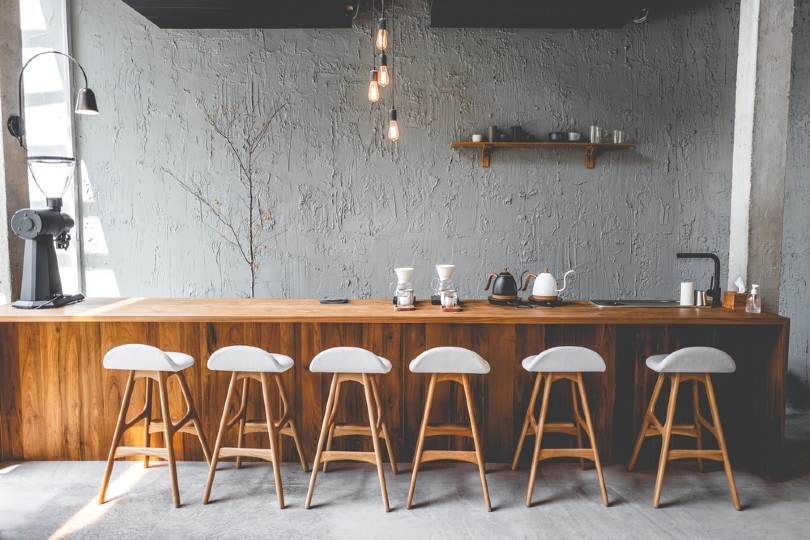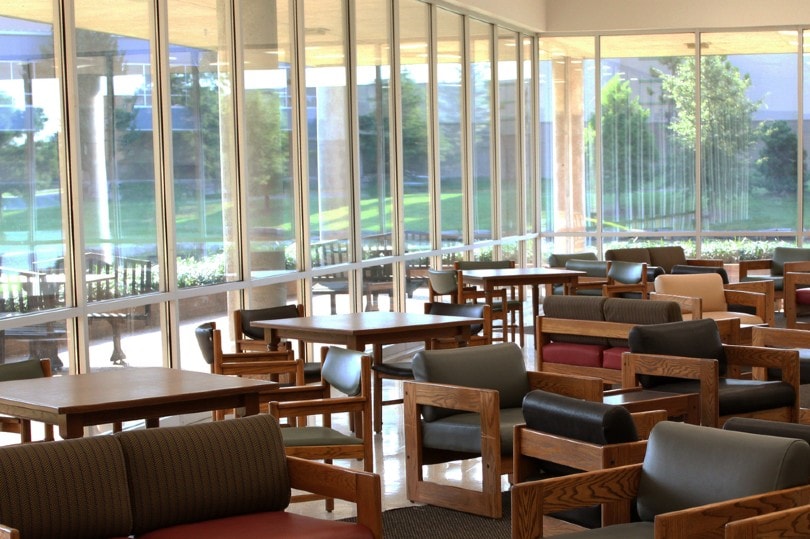8 Commercial Interior Design Trends in 2025
-
Kristin Hitchcock
- Last updated:

Due to the COVID pandemic, commercial spaces have changed a lot. While spaces used to be very modern and minimalistic, many trends are now moving to bring more of that homey feel into the office. After spending so long at home, many people are finding the transition back into the sterile office a bit abrupt – hence the modifications.
To make your office a bit homey, there are several different options that you can choose from. We’ll go over some of the most popular options in this article.
1. Wood Elements

A few years ago, most offices were metal (and quite sterile, to be honest). However, wooden elements are starting to come into fashion. They make the space feel much warmer and more inviting, which is exactly what modern commercial design is aiming for.
You can pair these elements with more industrial pieces, like the concrete floor in our example.
There is a wide range of wooden elements that you can utilize. For instance, you can use some simple wooden furniture pieces to bring just a splash of hominess into the room, or you can use floor-to-ceiling pieces if you’re using one as your main design element.
2. Cozy Chairs
No longer are straight, industrial chairs the only option for offices. In fact, we highly recommend choosing some other sort of chair for your main office area. While employees should preferably choose the chairs at their own workspaces (since everyone has their own preferences), comfortable chairs in communal areas are the way to go.
Your goal should be to make this space as inviting as possible. After all, you want your employees to spend as much time in these spaces as they can.
3. Permeable Boundaries
With more people working at home, most of those returning to the office need or want to quickly access others. Jobs that can be done completely alone have mostly been outsourced to work-from-home positions. Therefore, in your office space, you should attempt to make access to others as easy as possible.
One way to accomplish this is with permeable boundaries. Use bookcases and shelving to separate different work areas and provide some privacy. But workers can always shift to a new space with ease if they need to.
There is hardly any reason to have strict office spaces and permanent walls, especially if your goal is for workers to work together more.
4. Flexibility
Different people prefer different workspaces, and different work is done best in different areas. Therefore, your best bet is to provide as much flexibility in your office as possible. You want workers to be able to move easily between different areas as they need to. Sometimes workers will need to work alone at a computer. Other times, collaboration is key.
Often, a project will need to have both elements at different times.
Breakout spaces that are inviting and cozy paired with traditional workstations can work nicely.
5. Bring in Nature
Plants have a way of making an office space feel a bit more inviting and a little less sterile. Utilize succulents and ferns to break up the monochromatic space and provide some permeable separation.
Plus, plants can also clean the air and remove some of the interior pollution that is so common in an office space.
Plants work very well with other natural design elements, like wood, which provides a calming effect.
6. Large Windows

Large windows let in more natural light, which works hand-in-hand with allowing more natural elements into the office space. Natural light has countless benefits, including keeping workers energized and less groggy, which can be annoying and get in the way of productivity. (There is nothing worse than bumping up against a deadline and just wanting to lay down and take a nap.)
Pair big windows with some comfortable seating and plants, and you’ll have an inviting workspace very quickly.
Fluorescents may have lit the offices of yesterday, but we need to bring back natural lighting to create a welcoming office today.
7. Bold Colors
Once upon a time, offices were mostly designed with monochrome, “safe” color palettes. In other words, there was a lot of white and grey. However, you aren’t stuck with these neutral colors today. Instead, you can use bolder colors in modern offices, like blues and reds. Not only does this make the space stand out, but it also prevents it from feeling sterile.
Add in some natural light and plants to the mix, and you’ll easily have a space people want to work in.
Take a look at our example photo for an office that utilizes many of the design elements on this list.
8. Multi-Level
A great way to create a flexible space is to provide multiple levels that are open to each other. That way, workers can move between levels as they feel the need to, while also having some privacy. For this reason, you’ll find a lot of multi-level workspaces today. If you have the ability to create many different levels in your office space, do so.
Of course, this works as another permeable barrier. Participants can easily move between different spaces while also having privacy when they need to.
Conclusion
There is a lot that you can do to make your office space more welcoming to workers and encourage productivity. The sterile, florescent-lite workspaces of the last decade are no longer appropriate for this new era. We know that they just don’t work very well now, and how we can do better.
There are a few key elements that each modern workspace should have: nature, flexibility, and warmth. Utilize natural light instead of fluorescent bulbs, add plants, and use wood instead of metal. Be sure that your spaces are flexible. You don’t want everyone disappearing into their separate offices today, though workers should be able to find privacy when they need it.
Today’s offices may look very different from the cubicles that were once popular, but they aren’t terribly hard to achieve as long as you remember a few key design principles.
Featured Image Credit: Pexels, Pixabay
Contents

